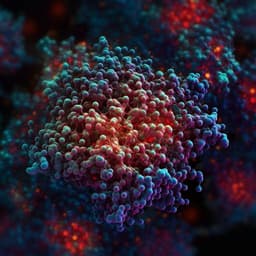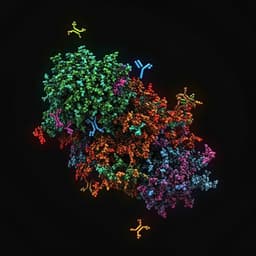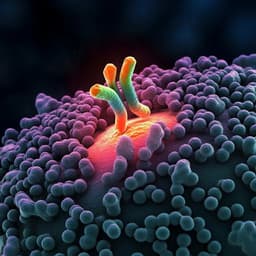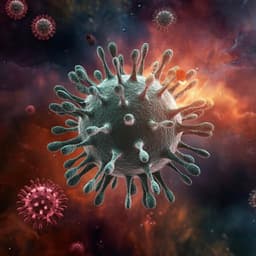
Medicine and Health
Potent neutralizing nanobodies resist convergent circulating variants of SARS-CoV-2 by targeting diverse and conserved epitopes
D. Sun, Z. Sang, et al.
This study explores the transformative potential of nanobodies in neutralizing SARS-CoV-2 variants, revealing their resistance to variants of concern and the discovery of unique neutralizing epitopes. Conducted by a talented team of researchers from the University of Pittsburgh and beyond, the findings highlight nanobodies' advantages over traditional antibodies, paving the way for innovative pan-coronavirus vaccines and therapeutics.
~3 min • Beginner • English
Introduction
The COVID-19 pandemic has caused major health and economic impacts. Beyond vaccines, neutralizing monoclonal antibodies (mAbs) from convalescent plasma have been authorized for emergency use, and camelid VHH single-domain antibodies (nanobodies, Nbs) have been developed for virus neutralization. Using camelid immunization with SARS-CoV-2 RBD and a proteomic pipeline, thousands of high-affinity RBD Nbs, including ultrapotent candidates, were identified. Nbs are highly soluble, stable, rapidly produced at low cost, and suitable for inhalation therapy; an ultrapotent Nb construct (PiN-21) showed high preclinical efficacy in a hamster model at 0.2 mg/kg, reducing lung viral titers by ~10^6 and preventing viral pneumonia. The ACE2 receptor-binding site (RBS) is a major serologic target and a hotspot for convergent mutations in circulating variants that can increase ACE2 binding and enable immune escape. Variants of concern include Alpha (B.1.1.7), Beta (B.1.351), and Gamma (P.1). There is a critical need for interventions with broad neutralizing activity against evolving strains. This study evaluates the impact of convergent RBD mutations and VOCs on ultrapotent RBD-directed Nbs, determines high-resolution cryo-EM structures of Nb-bound spike/RBD complexes, and compares Nb and mAb binding to understand mechanisms underlying broad and potent neutralization.
Literature Review
Recent work has isolated potent neutralizing mAbs from convalescent and vaccine-elicited sera, though many are susceptible to escape by RBD mutations common in VOCs. Multiple studies have developed nanobodies and synthetic sybodies targeting SARS-CoV-2 RBD, including multivalent and bispecific formats, with varying potencies. An ultrapotent aerosolizable Nb construct (PiN-21) demonstrated strong in vivo efficacy in hamsters. Structural studies have mapped neutralizing epitopes on RBD and identified conserved cryptic epitopes targeted by certain antibodies (e.g., CR3022). However, the breadth of Nb neutralization against circulating and potential future variants, and the structural basis for their resilience, required systematic evaluation. This work builds on and contrasts with prior mAb-focused studies by defining Nb epitope classes and their conservation, and by quantitatively comparing Nb versus mAb binding properties and sensitivity to variant mutations.
Methodology
- Variant impact on binding and neutralization: ELISA assays measured binding of seven diverse, potent RBD Nbs to WT and mutant RBDs, including single-point mutations (K417N, N439K, Y453K, A475V, E484K, N501Y) and double mutants (L452R, E484Q), as well as a highly evolved in vitro RBD variant (B62) containing nine mutations that increase ACE2 affinity ~600-fold. Pseudovirus neutralization assays evaluated Nb potency against WT, Alpha (B.1.1.7), and Beta (B.1.351) spike variants.
- Structural determination by cryo-EM: Prepared complexes of prefusion-stabilized spike HexaPro with Nbs (21, 34, 95, 17, 105) and trimeric complexes of RBD with pairs of Nbs (Nb105:Nb21:RBD; Nb17:Nb105:RBD; Nb36:Nb21:RBD). Data were collected on Titan Krios microscopes with Falcon 3 or Gatan K3 detectors. Image processing employed RELION and cryoSPARC, with motion correction, CTF estimation, 2D/3D classification, non-uniform and local refinements, and focused refinements to resolve Nb:RBD interfaces.
- Model building and analysis: Docked known RBD structures and built Nb models de novo in Coot, refined in Phenix. CDR3 loops were optimized using RosettaAntibody3 with restraints from a deep learning model (NanoNet). Interfaces were analyzed for contacts, buried surface area (FreeSASA), and interface curvature. Epitope clustering and conservation analysis used ConSurf scores and multiple sarbecovirus RBD alignments.
- Energetics: Molecular dynamics simulations (NAMD) with AMBER force fields and MM/PBSA calculations decomposed residue-level binding energies to assess contributions (e.g., E484) to Nb binding.
- Functional and biophysical assays: ACE2 competition ELISA evaluated Nb interference with ACE2 binding. Limited proteolysis (proteinase K) assessed spike conformational effects upon Nb binding. Negative-stain EM, thermal shift assays, analytical SEC, and DLS probed Nb-induced spike stability/destabilization, particularly for Nb36.
- Data availability: Cryo-EM maps deposited in EMDB (e.g., EMD-24255, EMD-24256, EMD-24257, EMD-23802, EMD-24262, EMD-23782, EMD-23790, EMD-23788) and atomic models in PDB (e.g., 7N9B, 7N9C, 7N9E, 7N9T, 7MDW, 7MEJ, 7ME7).
Key Findings
- Broad resistance of many Nbs to RBD mutations and VOCs: Most tested potent RBD Nbs showed minimal loss of binding to key single mutations and to Alpha; Beta (K417N/E484K/N501Y) markedly reduced potency of ultra-high-affinity Class I Nbs 20 and 21 (>1000-fold), with marginal impact on other Nbs.
- Future variant resilience: Against the highly evolved RBD variant B62 (nine mutations; ~600-fold ACE2 affinity increase), several Nbs were affected, but Class II Nbs 34 and 105 retained high affinity.
- Three structural epitope classes revealed by eight cryo-EM structures:
• Class I (RBS-directed, ACE2-competitive): Exemplified by Nb21 bound to spike with 1-up/2-down (3.6 Å) and 2-up/1-down (3.9 Å) states. Nb21 engages the extended RBD loop using all three CDRs; a central network involves Nb21 R31 and Y104 with RBD E484, and cation-π stacking with F490. MM/PBSA shows E484 contributes the highest binding energy, explaining E484K/Q as an Achilles’ heel for Class I.
• Class II (non-RBS, conserved, steric ACE2 blockade): Nbs 95 and 34 bound spike (3.4–3.5 Å), and Nb105 in a trimeric complex (Nb21:Nb105:RBD, 3.6 Å). Binding is dominated by long CDR3 hydrophobic contacts to conserved patches (e.g., Y369–F377, M379–P384, V407–R408; electrostatic E112:K378). Although not overlapping ACE2 directly, these Nbs sterically hinder ACE2 subdomain II and/or ACE2 N322 glycan. Class II Nbs neutralize potently (<150 ng/ml) and retain activity against VOCs; Nb95 and Nb105 bind both SARS-CoV and SARS-CoV-2 RBDs.
• Class III (unique, likely inaccessible to conventional Abs): Nb17 binds semi-conserved, non-RBS epitopes (residues ~345–356 plus adjacent sites) using all three CDRs without bulky aromatic packing; it locks spike into all-RBD-up conformations and increases protease susceptibility, suggesting promotion of premature S1 cleavage/post-fusion transition. Nb17 neutralizes with IC50 ~25 ng/ml and is largely resistant to dominant RBD mutations except L452R (Kappa). Nb36 targets a small non-RBS segment (353–360) with an orientation that clashes with neighboring NTD on intact spike; experiments (negative-stain EM, thermal shift, SEC, DLS) indicate Nb36 destabilizes spike. Nb36 binds a different epitope than CR3022 yet exhibits substantially higher neutralization potency (~7 nM).
- Epitope conservation: Median epitope identity across sarbecoviruses: Class I 50% (σ 11.1%), Class II 82.6% (σ 5.7%), Class III 76.5% (σ 10.3%). Class II (Nb95, Nb105) cross-reacts with SARS-CoV RBD.
- Nbs vs mAbs in variant sensitivity and binding mode: Compared to mAbs, Nbs less frequently rely on residues mutated in VOCs; 83% of mAbs use at least one variant residue (60% use two or more), whereas Nbs (especially in vivo matured) target these sites substantially less. Quantitatively, Nbs have slightly smaller average RBD interface BSA than Fabs (A_Nb 779 Ų vs A_Fab 862 Ų; p=0.055) but higher BSA per interface residue, greater use of CDR3 and framework (notably FR2) contacts, and preferential binding to concave antigen surfaces, supporting high affinity and breadth. The probability of Nb epitope residues coinciding with variant mutations is significantly lower than for Fabs.
Discussion
The study addresses whether potent RBD-directed nanobodies can broadly neutralize circulating and potential future SARS-CoV-2 variants. Functional assays and structures show that while ultra-ACE2-competitive Class I Nbs achieve exceptional potency, they are vulnerable to E484 substitutions found in several VOCs. In contrast, Class II Nbs target conserved RBD epitopes, maintain potency against Alpha and Beta, and exhibit cross-reactivity with SARS-CoV RBD, indicating potential pan-sarbecovirus utility. The newly defined Class III Nbs neutralize via ACE2-independent mechanisms—locking spike in an all-up state to promote premature conformational transitions (Nb17) or destabilizing the spike trimer (Nb36)—broadening antiviral strategies beyond receptor competition. Systematic structural comparisons explain why Nbs are less affected by convergent RBD mutations than mAbs: Nbs’ compact paratopes, extensive CDR3 and framework involvement, and preference for conserved, concave surfaces reduce dependence on mutable RBS residues. These insights support Nbs as promising therapeutics resilient to current and emerging variants and inform rational design of multi-epitope, multivalent, and cross-sarbecovirus Nb constructs and vaccine antigens.
Conclusion
This work defines three epitope classes of potent SARS-CoV-2 RBD nanobodies and elucidates their mechanisms and breadth against circulating variants. Class I Nbs potently block ACE2 but are compromised by E484K/Q; Class II Nbs bind conserved non-RBS epitopes, retain activity against Alpha/Beta, and cross-bind SARS-CoV RBD; Class III Nbs access unique, semi-conserved epitopes and neutralize by inducing conformational changes or destabilizing spike. Compared to mAbs, Nbs are less reliant on variant-prone residues and employ structural strategies (compact paratopes, CDR3/FR engagement, concave surface targeting) that confer breadth. These findings provide a framework for designing pan-sarbecovirus therapeutics and vaccines. Future work should evaluate in vivo efficacy of conserved-epitope Class II/III Nbs, develop multivalent/multi-epitope Nb cocktails, and assess combinations against prevalent and emerging VOCs (e.g., Gamma, Beta, Kappa, Delta).
Limitations
- Class I Nb vulnerability to E484 substitutions limits breadth against variants bearing E484K/Q (e.g., Beta, Gamma, Kappa).
- Structural limitations: Preferred orientations and flexibility hindered direct high-resolution mapping of certain interfaces (e.g., Nb105 on spike required trimeric Nb21:Nb105:RBD complex). Nb36 did not yield cryo-EM particles on intact spike; epitope and mechanism were inferred from RBD complexes and biophysical assays.
- Assay systems: Neutralization measured with pseudoviruses; Beta pseudovirus replaced del241–243 with I242H; in vitro-evolved B62 variant may not reflect in vivo evolution. Some mechanistic conclusions (e.g., Nb17-induced conformational effects) are based on proteolysis and structural states and require in vivo validation.
- Not all emerging variants were tested, and in vivo efficacy of Class II/III Nbs was not assessed in this study.
Related Publications
Explore these studies to deepen your understanding of the subject.







